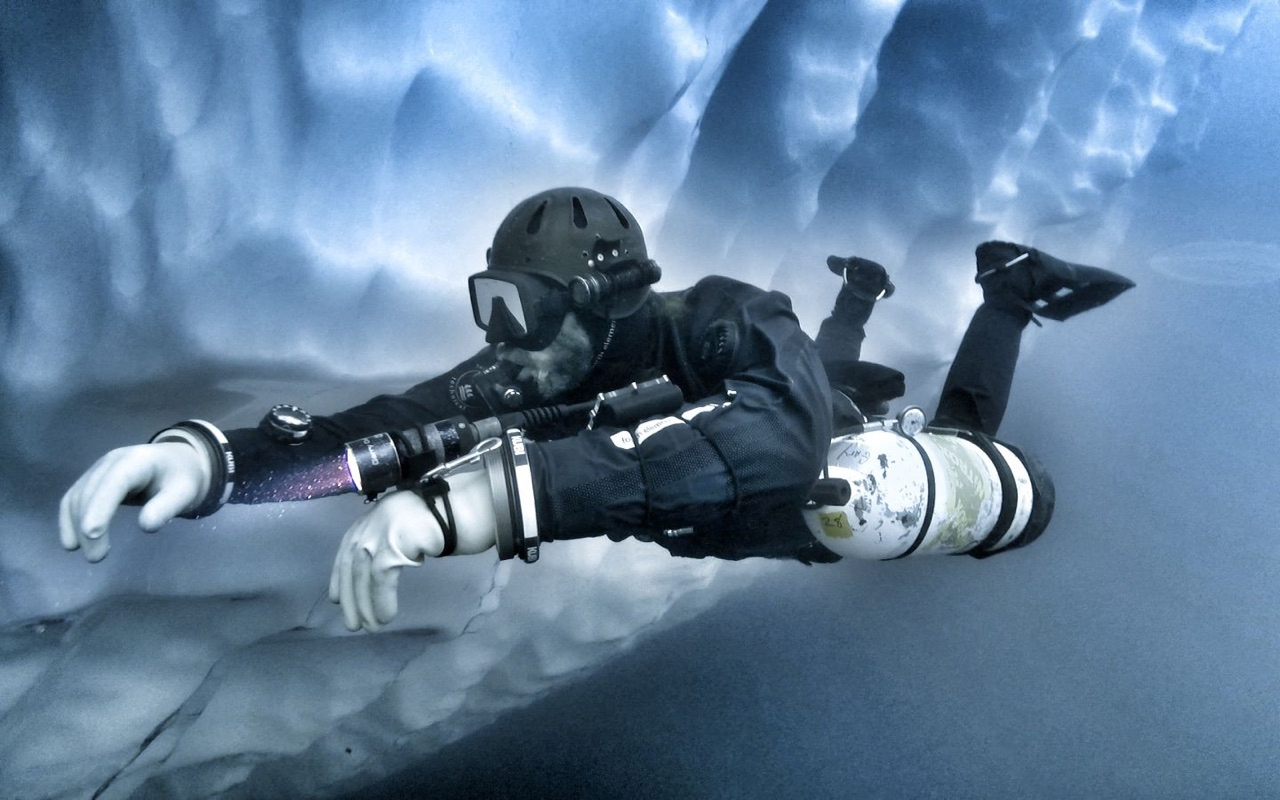Photographs by Mark Evans, Byron Conroy and Garry Dallas
As we are in the depths of winter, it seemed only right that our Dive Like A Pro section focused on cold water diving, or rather, what items of kit you need to safely and comfortably dive in chilly conditions. We also asked our experts for any tips and techniques for diving in cold water. So read on, and remember – just because the temperatures are plummeting, doesn’t mean you have to stop diving.
Setting up for a cold water dive
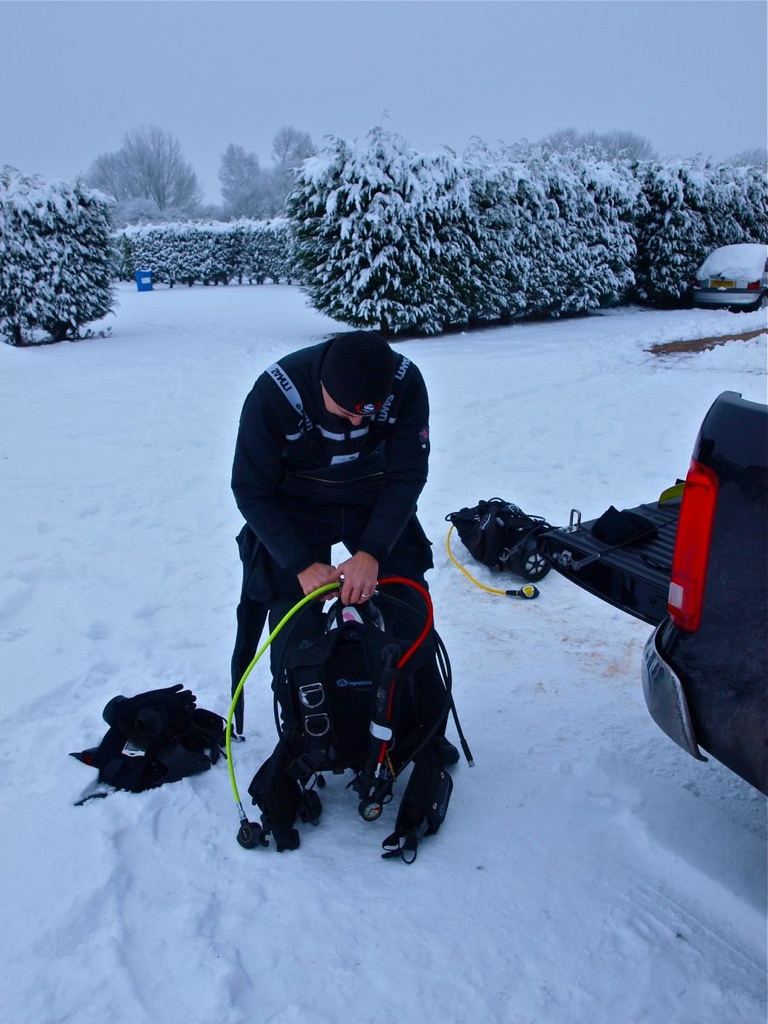
Alex Warzynski, BSAC Chair, Advanced Instructor and member of Nottingham University SAC, said: “Keeping warm while diving in cold water and cold air is a technique that does take a bit of thinking about. Getting into the ‘Ready Brek’ mindset makes it easy to explain – you need to generate a warm glow around you first thing, then preserve that glow throughout the day. A good place to start is a decent undersuit. After trying all sorts, here’s what works for me: layering. A decent merino base layer with thermals on top that you can add to or take away works well for me from break-the-ice temperatures all the way to late summer. The trick with any undersuit is that it must have some structure and resistance to collapse. An undersuit that resists the crushing from your drysuit will keep you warm.
“To keep warm from the outset, I stick my undersuit on after breakfast. I just get to the dive site, chuck my drysuit on top and I’m ready to go. Between dives, cheap ski gear is excellent at keeping warmth in – hat, gloves, jacket, fluffy neck warmer – all to maintain that core body temperature.
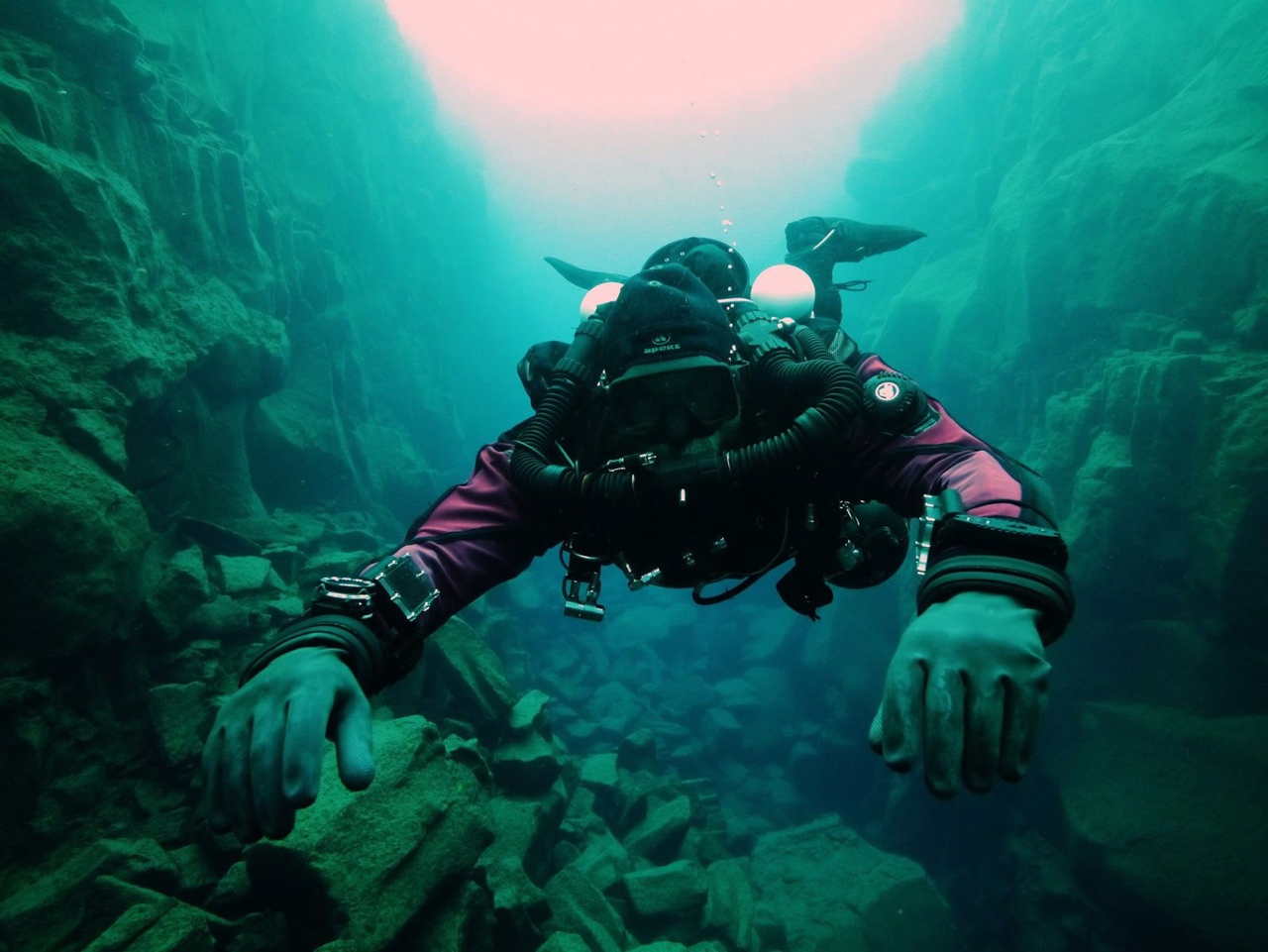
“So now we’re warm there are a few other things about cold-water diving you might not think of apart from the obvious reg free flows. Jumping into cold water with three battery bars on your dive computer might cause a premature blip as the battery chemistry can’t always cope with the cold. Ditto torches, cameras and strobes. Drysuit latex seals can stiffen in the freezing cold – this doesn’t damage them but before you do any stretching, the latex needs to be rewarmed so they’re flexible.
A leaky drysuit is particularly uncomfortable in really cold water – if you have a leak but can’t find it, try turning your suit inside out, unscrew the inflator and turn it round, then block off the neck and wrists with whatever you can find (footballs, pans, wine bottles, coke cans and traffic cones have all been used). Blow it up, and squirt soapy water all over it. The leaks will blow up a neat bubble. I have some tailor’s chalk in my toolbox to mark the leak position so once it’s bone dry, a blob of Aquasure sorts it or, for something more permanent and professional, two-part glue and seam tape.
“Winter diving can be very rewarding with a bit of forethought and preparation. As someone said to me many moons ago: ‘there’s no such thing as a cold dive, just the wrong kit!’”
Garry Dallas, Director of Training RAID UK and Malta, said: “To be honest, it’s the best time of the year to go diving in cold water. Less algae, more nutrients in the sea and therefore more marine life. It’s a no-brainer, although sometimes in very cold water a lack of good thermal protection on yer bonce can lead to brain freeze in the first 20 seconds or so.
“Looking at thermal protection… don’t skimp, keep warm! Everywhere from head to toe needs another layer. Only wearing the extra sweater does add more buoyancy to the top of your body and knocks your hovering trim out a bit. To keep yourself in trim, wear the socks and bottoms too. Wet gloves… well, here’s the time to invest in some dry gloves, they prevent water contact with the skin that chills your hands down to the bone! So, you’ll be glad you got them. The thicker the under-glove, the more air gets in your gloves to keep you warm. Just make sure both inner and outer gloves fit you… well… like a glove!
Cold Water Diving in Iceland
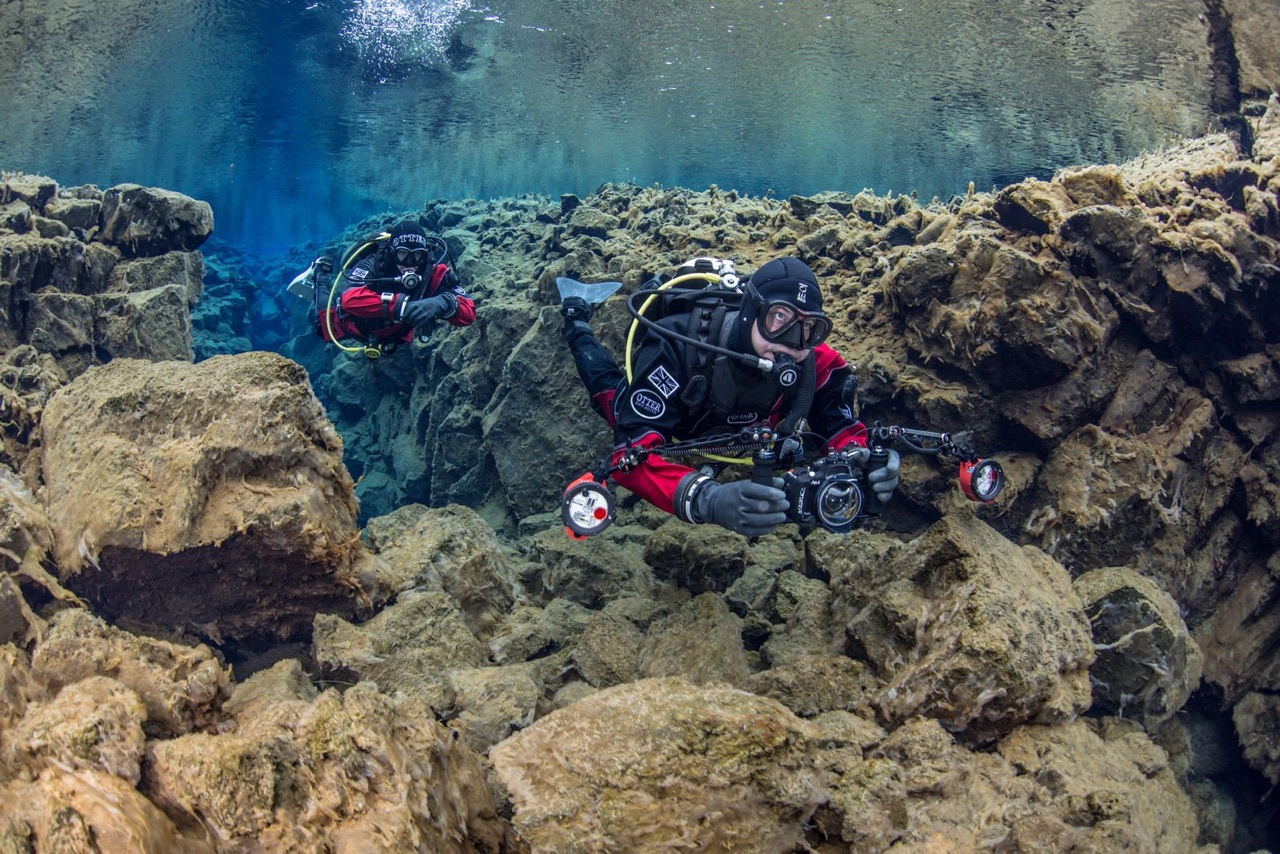
“Heated vests… they are awesome! Externally battery-operated vests are easy to shut off, if there’s a problem, but internal ones aren’t. Be cautious of misusing the burn-time (usable power) of the vest; diving with your vest warming your body and keeping blood circulation going during the first part of the dive (normal on-gassing), then finding towards the end the battery runs out will cause your blood circulation to slow down, preventing normal off-gassing and can cause your body to develop DCI symptoms.
“Make sure your wrist seals aren’t too tight, in cold water, now that your torso has redirected the blood flow within it, your hands will become colder even quicker.
“Scuba equipment… remember, the air temperature can often be colder than the water temperature, so breathing off a second stage regulator in 0 or sub-0 degrees out of water can cause the first stage to freeze prematurely. Turn the second stage breathing adjusters down, easier breathe – easier freeflow. Don’t use warm water regulators below 8 degrees C. Inflator buttons can stick through lack of use, so as usual, make sure all your equipment is serviced properly. Always suck a negative pressure test on the second stage regulator to check it works before you connect to the cylinder.
“Finally, keep warm, before and after a dive, don’t be a ‘hero’ unless you’ve got a pee valve fitted, it really does hurt if you can’t go!”
Will Harrison braving the snow for a cold water dive
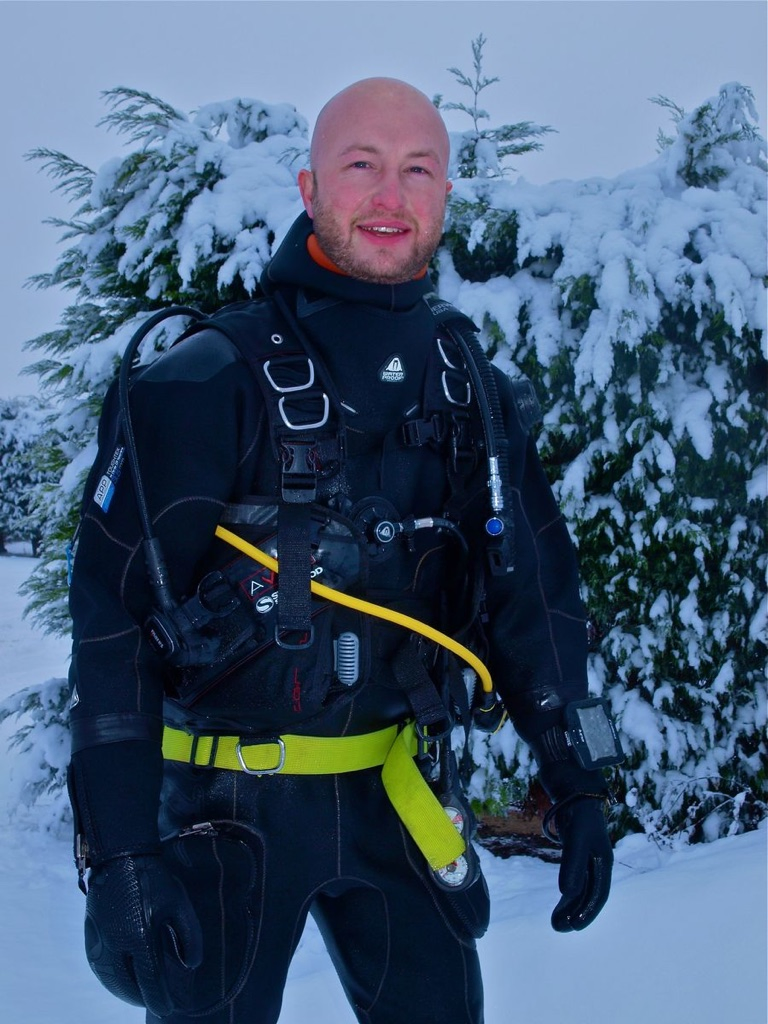
Mark Powell, TDI Instructor Trainer and Training Advisory Panel Member, commented: “Many divers seem to laugh or think you are joking when you mention diving in the dead of winter. Cold-water diving may not appeal to everyone out there. But for some, cold water brings the best visibility, solitude, and a very unique aquatic environment. Around the world, quarries, lakes, rivers and even ocean dive sites are swamped with people when the weather is warm and the required exposure protection is minimal. When the weather turns cold, you often have many of these dive sites to yourself. This means when you head to the water to dive, you and your buddy may not have many other divers to ask for support, so you need to take the items you need to remain comfortable. A few of the items that you may wish to have are listed below.
“Any type of physical activity can cause a person to get dehydrated. When the weather is warm and the sun is shining, it is much easier to recognise that we have been sweating and need to replace fluids. Conversely, cold weather often makes us bundle up and avoid cool drinks. When you head out to any dive site, especially a cold-weather site, remember to throw some water in the car. Between dives and around our aquatic activities, we need to remember to replace fluids and stay hydrated. This will make us feel better and ensure time at the dive site is much better. Similarly, cold weather always means it is a good time for hot drinks. Prepare a thermos and take some hot chocolate (or another hot fluid) out to the dive site. Nothing is better than leaving the water, throwing on your warm clothes, and then sipping a hot cup of coffee or chocolate drink. Your dive buddy will think you are the greatest person in the world.
“Just like fluids, we burn off calories when we dive. The act of adding bulky equipment such as extra exposure protection and the longer preparation time needed to set up and don gear for cold-water diving can make a diver burn off a large number of calories. As we exercise, we get tired and our bodies need more fuel to operate at a maximum level. Taking snacks to the dive site will make sure we have something to munch on and to replace calories after a long dive in cold waters. Essentially, these snacks can be true comfort food to make a diver feel better.
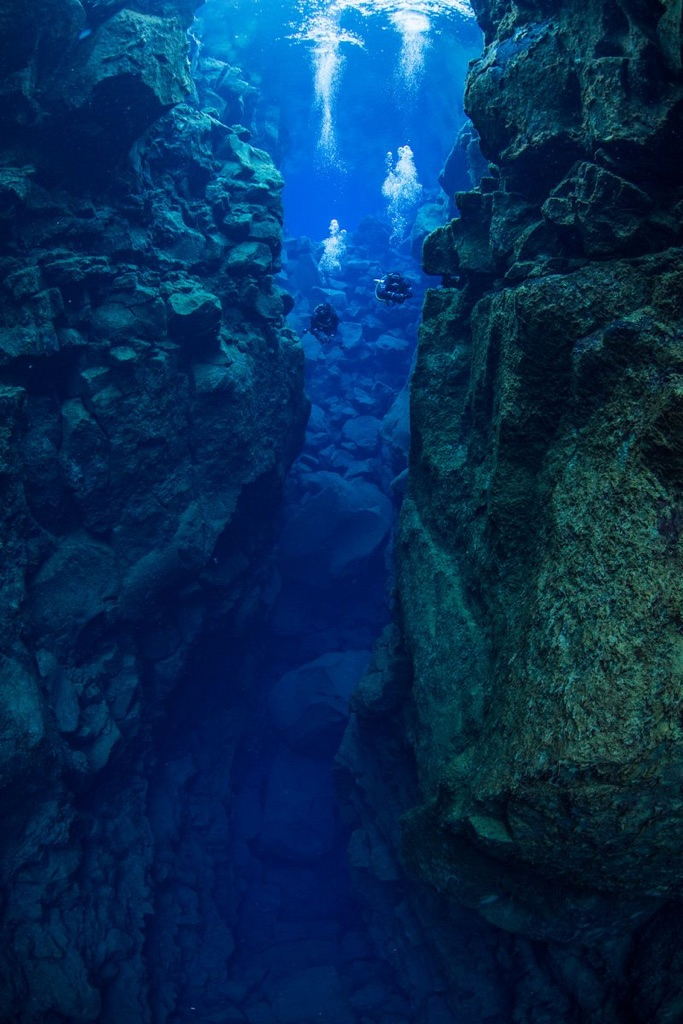
“One of the most-critical things that a cold-water diver needs may be undergarments. If you do not know what these are, they are clothes worn beneath a drysuit to provide thermal protection. When you pack your gear up and head to the water, why not throw some extra items into the car? Most companies that make undergarments often make layering systems. By taking more than one set of thermals to the water, you will know you have multiple options available to you to help you stay warm. Things like liners also fall into this category. Liners help wick sweat away from the body and provide an extra layer of thermal protection beneath normal undergarments. In many instances, liners can really help your hands and feet to stay warm. They are inexpensive items that take up almost no room. So why leave them at home.
“If you have never seen a first stage fail in cold water, it is amazing to see. Many divers would be surprised to know that a first stage can freeze in water temperatures well above freezing. Cold high-pressure gas moving through tight spaces expedites the freezing process. So, if you know you are planning on diving in cold water, why not give yourself peace-of-mind? Make sure you get your hands on regulators ready for cold-water diving. Often, these are diaphragm first stages or a first stage with an environmental seal to protect the system. You should not have to worry about temperatures and failing life-support gear during a dive when worries such as these can be completely avoided.
“If you have done much cold-water diving, then you have misjudged temperature at some point and experienced an ice-cream headache without the delicious treat underwater. Cold water against the soft tissues of the head can be a miserable experience. Similarly, if you have stayed in chilly water too long before, then you know what it is like for your hands and feet to begin to chill. Eventually they become like blocks of ice. For these reasons, thermal protection for your head and hands should always be carried along for cold-water dives. Hoods and gloves take up minimal space, so it may even be worth carrying multiple options with various levels of thickness and protection. If you do not need these items you will not mind leaving them at home, but you will kick yourself if you need options and just did not throw them into the car.
“One of the most-miserable things for me when diving in chilly waters is if my feet grow cold. Once they get too cold, it seems like my feet will never be normal again. This worry causes me to pack multiple socks when I head out for a cold-water dive. These socks may include normal running socks, heavy wool socks, and even Thinsulate undergarment socks. The ability to layer thermal protection on your feet will help you stay warm, but having extra pairs of socks means you can keep your feet dry and warm no matter what happens. In a drysuit you almost never stay truly dry. Be it a small leak or sweat, you will be damp somewhere. Remember that fluid runs downhill, so having dry socks in the car on a cold day can fix a world of problems if they happen. Similarly, remember to carry real shoes or boots to the dive site. Cold weather may mean slush, snow, or just low temperatures. Keeping your feet warm and covered while you prepare for your dive, or following the dive, will help you remain comfortable.
“Just like socks and shoes, a jacket and warm clothing can serve similar purposes on a cold dive site. The ability to remain warm while you prepare and break down your gear can be critical. Why would you risk being cold when a jacket could fix this problem? Remember to toss warm dry clothes into your car that are not used as undergarments. This will give you a warmth option on the surface if nothing else is working.
“People lose a huge amount of heat through the head. Wearing something as simple as a hat or beanie can help a diver stay warm while walking around a dive site. Think about it. Almost every thermal protection company makes and sells beanies, which is why TDI/SDI have just launched a new beanie. You wear a hood to remain warm underwater, so why not a hat on the surface? Simply wearing a hat can help a diver retain large amounts of body heat and remain warm before, between, and after dives.
“One of the wildest helpful items on a cold-water dive is anything heated. Various companies make heated undergarment systems. These systems often require battery packs. If you have one of these, why leave it at home? Accessories such as heated systems for drysuit diving can make a day of diving much more enjoyable. Take time to check out what is available and see what is right for you.
“Lastly, no one likes breaking down and cleaning equipment in the cold and wind. One of the easiest ways to simplify your life is to keep large storage bins in your vehicle. Bins allow you to simply place damp equipment into containers that will protect your car. Once home, you can carry the containers inside and break down and clean your gear in comfort. This type of planning will keep you from standing in frigid air breaking down gear and worrying about getting your car wet.
“Cold-water diving can be very fun. It is a unique experience that offers different types of challenges, but challenges can be fun. Just remember that when you head to the water, plan for your own personal comfort. There is no reason not to try and remain warm. Pack the extras into the car that can make you have a good time and remain comfortable. Again, these are just a few suggestions that can help you enjoy your time at the water when it is cold, but think through what you may need or want, and develop your own list.”
GUE’s John Kendall said: “Diving in the cold can be incredibly rewarding. You are often greeted by very good visibility, and often the dive sites are a lot quieter. However, there are numerous downsides and risks. The two obvious risks are equipment malfunction and diver malfunction. As the air and water get colder, there is a much higher likelihood of freeflows from your regulators. To avoid this, make sure that the regs are correctly tuned, and turn down any venturi assists. Also avoid breathing the regulators above water too much. In truly freezing conditions (such as ice diving), none of the regulators will be breathed above water. Believe it or not, the water will help keep the first stage warmer (as the water rarely gets much below 4 degrees C, whereas the air can be well into negative temps). You should also consider having truly redundant gas sources (such as a twinset) so that neither first stage is feeding more than one second stage. This will help reduce the load on the first stages if you end up gas sharing.
“In terms of diver malfunction, we have all experienced this to some degree. Humans get more stupid as they get cold. The body starts changing its blood flow to keep the central organs warm, and the brain goes into a survival mode. This means we are less likely to make good decisions when we are very cold. Staying warm is a must, and this starts before the dive. Make sure you are well rested, and eat a proper breakfast before the dive. Slow release carbs, such as porridge, are great for this. Then make sure you don't get too cold on the surface prior to getting in. Standing around on a cold carpark is a pretty good way of losing core body temperature before we even get wet. Make sure you have adequate and good undergarments, and a dry drysuit.
The best undergarments will still keep you warm if you are a little damp, but a flooding suit can be particularly dangerous in cold water. A good measure of how well an undersuit will insulate you is the amount of buoyancy that it has. Generally more buoyancy means more trapped air, and it's that air that keeps you warm. A good hood and gloves are also essential. Personally, I wear drygloves for any cold diving. Electrical heating has become more popular and easy to acquire, but be careful of it. Batteries inside the drysuit can lead to nasty burns if the conductors get damaged, so external batteries are the safe way forward. And be mindful about running the heating all the time, if you have deco to do, it is better to try and avoid using the heating too much on the bottom phase, but keep it for the decompression. There has been a lot of research done by the NEDU about this, and cold on dive, warm on deco is the safest way forward.
“Finally, don't be afraid to call the dive early if you are getting cold. Remember, we dive for fun, so if you're not enjoying it, then get out.”
